Second to Nature
By Chris Ritter ’21 for Bowdoin MagazineBowdoin surfer stories span generations, all rooted in what surfing provides—a grounding force through uncertainty and a steadfast connection to nature, a mark of resilience, a measure of passion, and a path toward inclusive community in the outdoors.
In Maine’s cold water, there’s a sense of being both a part of and apart from the world, in a moving meditation built on taking, receiving, and riding the waves, open to what is given.

On a particularly terrible afternoon at Higgins Beach, my roommate, John Lane ’21, and I were the only ones out in an ocean that looked like soapy bathwater. It was forty degrees, warm for early March in Maine, but the water was probably close to forty too. A crosswind howled up the bay, churning the water into a foamy mess, with waves breaking into each other in every direction. There’s a very specific kind of pain that comes from dunking your head underwater to evade a broken wave. It’s a feeling remarkably similar to brain freeze, but it’s more malicious than anything you might get from a bowl of ice cream. Maine surfers know the feeling well.
I learned to surf during my first year at Bowdoin. My roommate, who grew up down the road in Yarmouth, had surfed his whole life. I, on the other hand, had about as much surfing experience as you’d expect from an eighteen-year-old who grew up nowhere near the ocean in western Virginia. I grew accustomed to following John into truly horrendous conditions. Most days, when I asked him how the waves were, he’d reply with one of a number of catchphrases he used to egg me on. Among them were “doable” or “could be fun” or “yeah, there could be a little something out there.”
On this day in 2019, in our sophomore spring, there was definitely “a little something out there.” Whether it could be fun or was even doable was in serious doubt.
By then, a community of surfers had grown at Bowdoin. What once seemed like an inside joke between roommates was blossoming into an eager community of folks willing to cancel plans, wake up before the sunrise, or brave nor’easters to hurl themselves into the ocean, and then, for some reason, choose to come back.
But on this particular violent day in midwinter, it was just me and John. In the brief moments of peace between set after foamy set, I asked myself the only question worth asking in that situation.
It’s a question every Bowdoin surfer has asked themselves, I think, at one point or another, head throbbing while looking out at the blank sea—why am I surfing, and why am I surfing here?
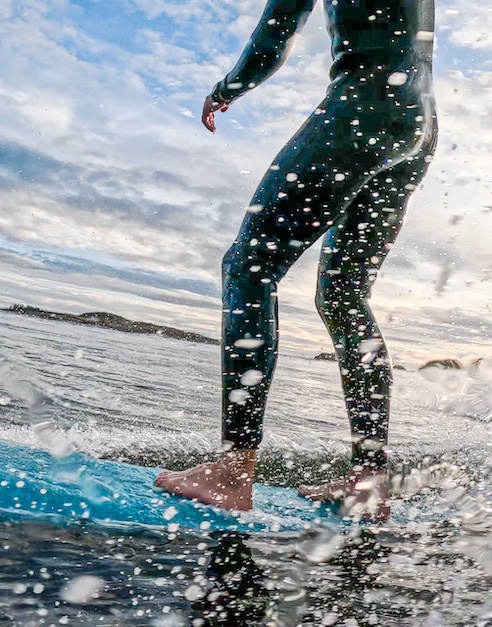
Bowdoin students have been surfing in Maine since at least the mid-’70s. With no phones, internet, or Surfline to forecast the waves, students like Hank Lange ’76 and Sprague Ackley ’76 relied on NOAA weather radios and a fair amount of luck to score waves. “People came to surf activity in organic and chance ways,” according to Dave Menz ’85. As a sophomore, Menz remembers living upstairs in the house of former director of Moulton Union Don Lancaster, which sat on the lot now occupied by the Roux Center for the Environment. That year, Menz found a seven-foot-two, red-finned Plastic Fantastic board in Lancaster’s garage and started going on trips.
Stories of those early trips read like the stuff of other early East Coast surf lore—half epic mission into the unknown, half DIY school project. After finding the Plastic Fantastic, Menz went with Scott Harrison ’85 to a dive shop in Brunswick to look for a wetsuit. Having pooled their money, Menz and Harrison could afford to rent one half of one wetsuit for an afternoon. They went with the top—a quarter-inch-thick wetsuit jacket with a beaver-tailed bottom and nothing to cover the legs. With one board and one piece of wetsuit to share, Menz and Harrison were forced to take turns surfing, while the other would watch from behind a rock on the snow-covered beach. Other times, they went with no wetsuit at all, wearing wool caps and “some other ridiculous clothing modifications, which failed,” said Menz. “It was obviously so crazy.”
It’s an understatement. Reading Menz’s account of these trips in an email, I think, These guys were insane. Having surfed here, I’ve been advised by people who know better than I do that doing anything in the Gulf of Maine in winter requires a full wetsuit that’s at least five millimeters thick, along with booties, gloves, and a hood that covers as many inches of your face as possible. I’ve been close to hypothermia wearing all of it.
But, not knowing better, Menz and company made it work. It was February of 1983, before you could order gear online and before surf shops dotted the East Coast.
By spring, a community was growing. Menz and Harrison were joined by a group of five or six like-minded surfers who had caught wind of their misadventures along the coast.
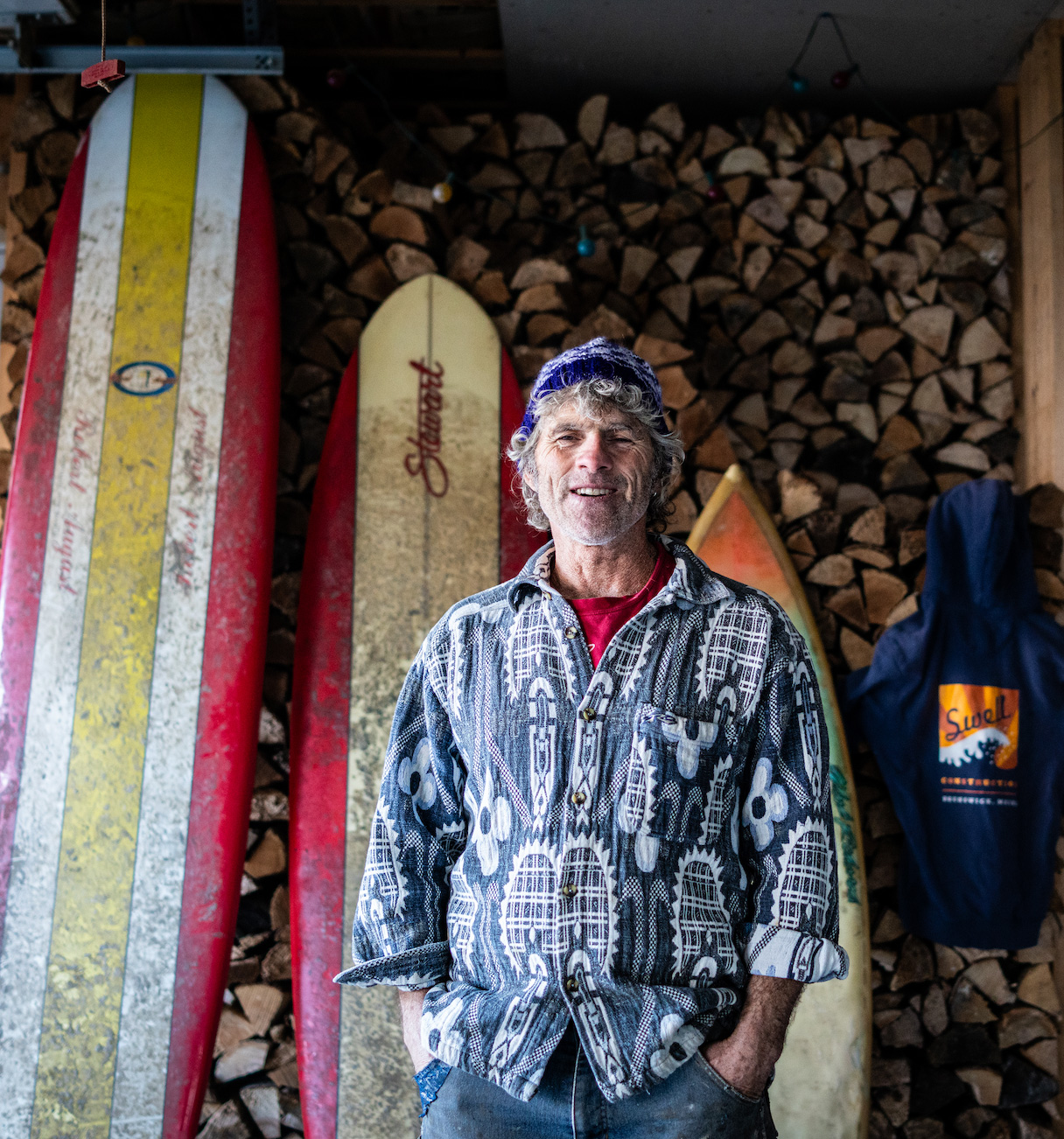
Among the group was Adrian Bossi ’85, a frizzy-haired carpenter from Cape Cod who remembers those trips with a wistful fondness. I meet Bossi outside his home in Brunswick, and he gives me a sampling of his favorite memories from those early trips—scoring hot chocolate and peppermint schnapps in the water from some local kayakers, listening to Beach Boys tunes on a Sony Walkman on the beach with the crew while watching one of them surf in their lone wetsuit. Eventually, Bossi got his own—a holey yellow-and-orange suit that he covered in Saran Wrap to keep the water out (remember Menz’s ridiculous clothing modifications, which failed).
It had no designation on campus, but the group eventually dubbed themselves the Subzero Surf Club. They were a dedicated bunch. Forecasts be damned, Bossi remembers going with the Subzero crew to check the waves “every single day.” They would go to Small Point, a finicky right-point break not far from Popham Beach.
“If the waves weren’t good, we’d still just go in the water and splash around,” said Bossi. Bossi has since surfed in Australia and the South Pacific, but he remembers his time surfing in Maine as particularly special. “I’ve surfed some great spots, but just the camaraderie of surfing with those friends in Maine made it so much better there.”
Menz sees it the same way. “At the end of the day, what became clear to us was the joy of immersing in wild nature, where sea meets land, together with friends,” Menz writes. “That’s the mere simplicity of what we were up to, and that spirit has remained with us throughout our lives, as we are still immersing in the wilds.”
Tagging along on many of those trips with the Subzero crew was a kayaker—Mike Woodruff ’87. Perhaps no one has seen more of Bowdoin’s surf history than Woodruff, who paddled out with the early members of Subzero, and is known to students today as the head of the Bowdoin Outing Club, a position he’s held since 1992.
Woodruff recounts how, until recently, Bowdoin’s surf scene was usually limited to a group of six to ten at a time, mostly made up of people who weren’t dedicated surfers until college. “Nowadays, we have a bunch of surfers who come in with experience, and they plug right in,” Woodruff says. “Back in the day, guys were kind of just reinventing the wheel—finding boards in a basement or a garage and figuring it out with a Saran Wrap wetsuit.”
There’s joy in reinventing the wheel, though. Woodruff talks about the misadventures of his Subzero friends with the same reserved spark as when he talks of the generations of beginner surfers who have rolled through trips with the BOC.
“You don’t have to be an advanced surfer to totally get your life’s energy from it,” Woodruff says. “No matter the conditions or your ability level, it’s already a net gain to spend the day outside—and then, when you do have an awesome day, it’s mind-blowing.”
This is a graciousness fitting for people who surf, especially in Maine. For those who immerse themselves in it, surfing anywhere is more than just an activity—it’s a way of life, a guide for surrendering to the unpredictability of nature and finding joy in whatever comes. In Maine, with its always frigid waters and rarely consistent waves, perfect days happen but are few and far between. Ask anyone who’s surfed here, and they’ll tell you it makes those days even sweeter, and every day in between more worth showing up for.
While there have almost always been a few stoked surfers at Bowdoin, Woodruff says that, compared to other outdoor sports, the BOC has had a harder time finding those willing to teach surfing to beginners. As surf crews came and went, for years the scene stayed limited to the few obsessives willing to seek out the sport largely on their own.
But, slowly, that would change.

The first time Zoe Wood went surfing, she was teaching it. Wood ’18 was studying abroad in Chile, and she had volunteered to work with a local environmental nonprofit near the coast. She was tasked with teaching English, environmental lessons, and surfing—the latter of which she had never done before.
“Suddenly I found myself pushing kids into waves and yelling, ‘Stand up! Stand up!’ when I couldn’t really surf myself,” says Wood.
But when presented an opportunity to share her love for the ocean with others, Wood ran with it. Wood grew up New York’s Hudson Valley, but she fell in love with the ocean swimming in the waters near her grandmother’s house on Long Island in the summer. The ocean guided her decision to come to Bowdoin, and it continued guiding her life from there.
When Wood returned to Maine for her senior year in 2017, surfing was more accessible than it had ever been at the College—the Outing Club had a sizable fleet of foam boards, and vans took several trips to the beach per week—but big challenges remained. BOC surf trips would fill up within seconds of them going live online. Before they were leaders themselves, Shona Ortiz ’21 and Abby Wu ’21 remember, they pestered leaders to tell them when they were going to post a trip so they could refresh their screens at just the right moment like they were in a Ticketmaster queue.
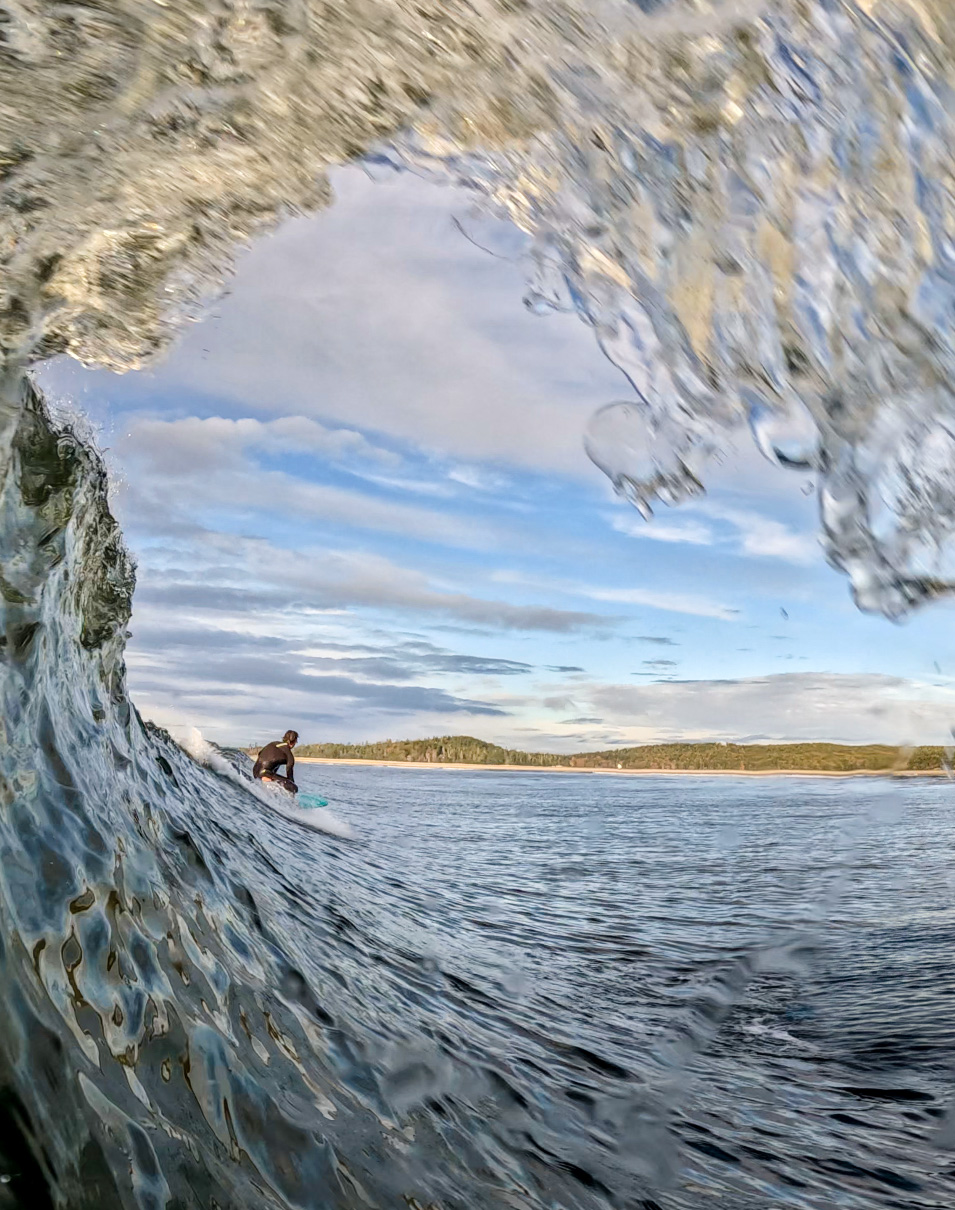
If you couldn’t land a spot in a BOC van, you’d need a car, a board, and a wetsuit, or to find someone who could supply you with all three. And that’s just to get in the water.
There are more pervasive barriers too, and Wood knows them well. Wood and other women surfers I talk to, especially those of color, have faced their share of suspicious looks and snide remarks in the lineup, in Maine and elsewhere—You know there are waves further inside, right? Do you know how to coat your board?
“I feel like I’m always scanning the crowd to see how many women and how many people of color are out there; it can really change a session,” says Wood.
It’s clear that she takes that awareness with her when she teaches. “It’s really important for someone to feel welcome in their first experiences in surfing, because that feeling of not belonging can be really insidious.”
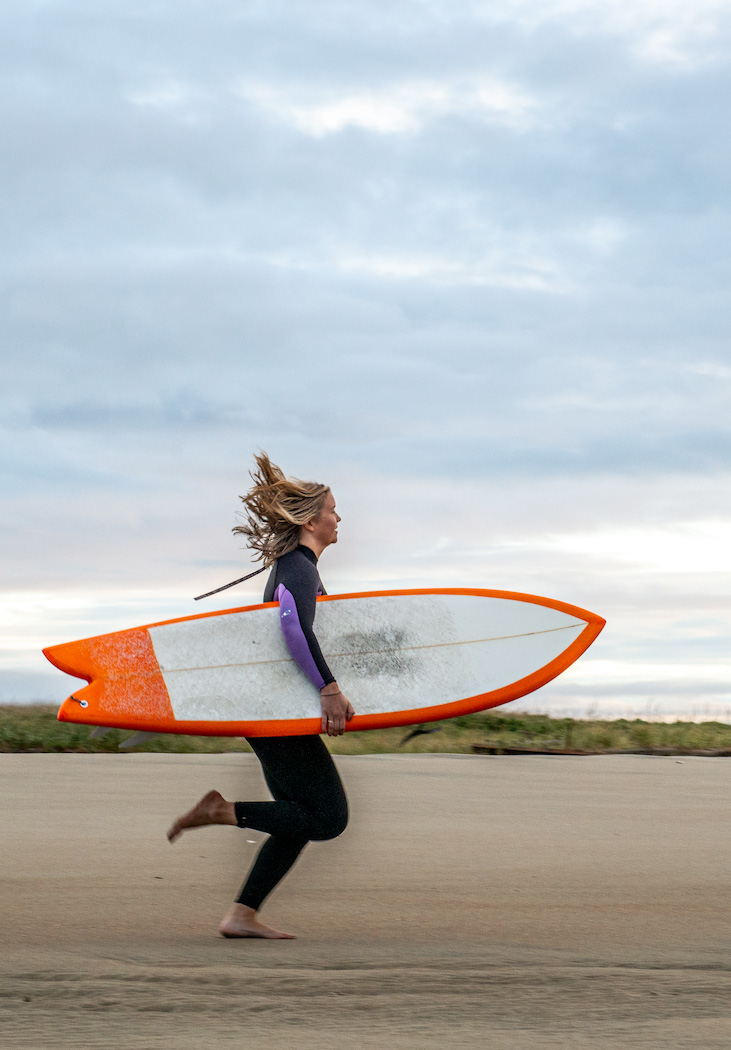
Those feelings are only compounded by a sport where the learning curve is already steep. Wood notes a truth well known to anyone who starts surfing past their adolescence—before you’re any good, you’ll spend a long time being very, very bad. In Maine, you’ll also be very, very cold and battling inconsistent weather and raucous waves. It’s a sport where confidence, even blind confidence, is almost a prerequisite.
Bowdoin surfers have used many different tools to break barriers to surfing here, makeshift wetsuits and NOAA radios included. But teachers who are aware of those barriers are among the most vital.
“Surfing is such a joyful sport, and there can be a lot of barriers to feeling that joy,” says Wood. “But that feeling of surfing, where you’re in total control but also letting go and responding to what the ocean is doing, it’s just the best. I want everyone to have that.”
After Bowdoin, Wood had a job offer that would take her to Colorado, but she couldn’t make herself go. Too landlocked. She stayed in Maine and spent some more days trading waves at Higgins with Maine locals and other Bowdoin grads before moving to California.
Wood wasn’t the only teacher to help bring more people into the water at Bowdoin—she cites Hannah Baggs ’17, Jamie Ptacek ’17, and Ella Driscoll ’17 as important surf leaders during her years at Bowdoin. But Wood was part of a generous group of people working carefully at being better stewards of the sport, making it easier for all folks to get a glimmer of the obsession. They were sowing the seeds of a community, leaving them for those who came next.
“Am I stupid?”
It’s 2019, and Evan Knight ’22 is standing naked in the snow again. It’s probably around 8:00 a.m. It’s also eight degrees, and Knight has just come in from another midwinter surf session with Stephen Boe ’22. They’re both crab-handed and, having used most of their energy to peel off their soaked wetsuits, Boe is having a hard time unlocking the car. Warmth rapidly exiting his body, Boe asks himself another question—“Do I die here?”
Fortunately, they don’t. Knight recalls the morning with a laugh, sitting in his wonderfully roomtemp apartment. Hailing from Santa Barbara, Knight has surfed most of his life, and has always looked the part—on campus, Knight was notorious for longboarding to class barefoot well into the fall and winter. Today, Knight lives in New York with Boe, another lifelong surfer. The two work together and surf on Long Island together, and they remember their surf stories together like the Subzero crew does—graciously, lovingly, and happily aware of their own ridiculousness.
Lifelong friendships have formed over surfing at Bowdoin since the Subzero days, but it was more of a chance occurrence then. By the time Boe and Knight met, if you were looking for surfers on campus, you didn’t need to rely on chance to find them.
Spots on BOC trips went quickly as ever and, outside the BOC, surfers began to organize in new ways. Soon, the Bowdoin surf scene had what was, at the time, the hallmark of unofficial Bowdoin community-building—a group chat. At its peak, the chat held as many as ninety people.
When waves were good, the chat flurried with plans to coordinate sessions around class and social schedules—cars left before sunrise or raced from campus to catch the last bits of daylight on winter afternoons. Surfers still went to nearby beaches like Popham but were more commonly going south to the Scarborough area, like Higgins Beach, for more consistent breaks. When waves were bad, people sent ideas for dream trips to places like Nova Scotia, or, more frequently, plans for watch parties of the animated film Surf’s Up.
“It was a really beautiful, fun thing,” recalls Annie Schiffer ’21. Schiffer, who ran on the track and cross-country teams, was drawn to the informality of surfing. “A lot of activities at Bowdoin are very based on goals, like winning a game, or making a magazine. The surf group just kind of emerged out of a lot of people who wanted to find others who wanted to do this one thing.”
Schiffer, originally from inland New Jersey, was one of a host of people around this time who had never surfed before Bowdoin, but who became prominent members of its surf scene by simply wanting to go all the time—frothing, in surfer speak. Schiffer was hooked on the sport and the social scene that was forming around it: “You would have these forty-minute drives to Higgins or Popham and get to know people in a close, but laid-back way.”
As for the cold? Well, for those willing to venture out in winter, it made the camaraderie even stronger. “In Maine, there’s this deep mutual respect in the water that I love,” says Knight. “In the winter, it doesn’t matter how good you are at surfing, you just kind of see other people in the water and are like, whoa… you really want this shit.”
Group chats and hypothermic trauma bonding aside, people still stumbled into surfing in more familiar, chance ways. Sydney Reaper ’21 reminds me that the first of many surf trips we took together came to fruition when she saw me pull a wetsuit out of the dryer in the basement of Coleman Hall, our first-year dorm.
Methods vary, but people pulled by the ocean tend to find each other.
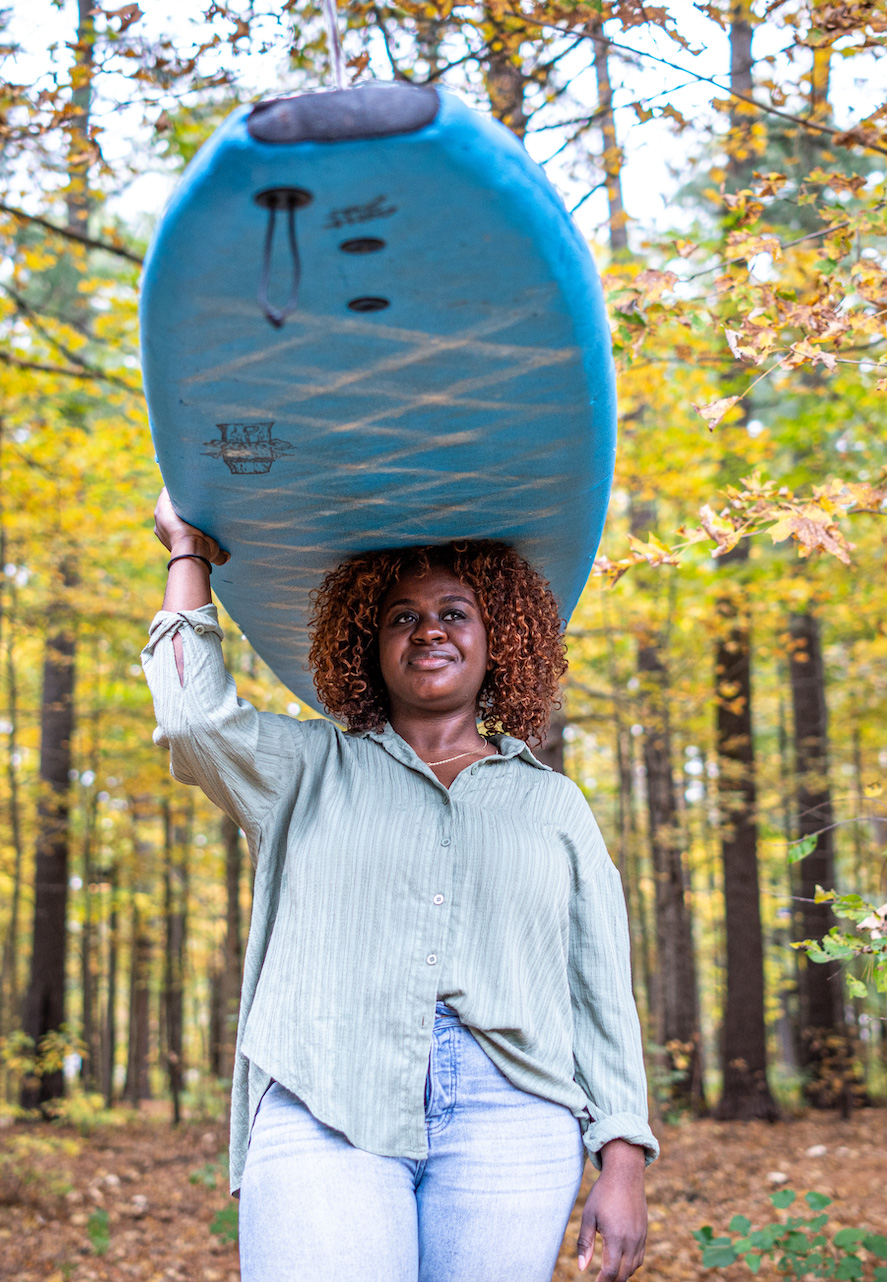
I meet up with Sapphire Hall ’25 and Alex Washburn ’25 in the BOC kitchen. It’s around dinnertime, and I had planned on eating the chocolate-covered pretzels out of the giant barrels I remembered from my time in this room, but Hall starts making pancakes, and offers me one. We take seats on the barrels of pretzels, GORP, and other familiar things, and start talking about surfing.
Some things haven’t changed. Hall tells a story of one of her first times surfing in Maine with Washburn, where she forgot part of her wetsuit and paddled out at Higgins in neoprene Farmer Johns and a black puffy jacket.
“I could not believe you did that,” Washburn laughs. Unbelievable, sure, but fitting for someone at a college whose surfers have thrived on ridiculous clothing modifications, which failed. Both Hall and Washburn grew up surfing—Hall in South Carolina and Florida, Washburn in California. Woodruff had told me about both of them. With about twenty years of surfing experience between them, they’re both staples of the BOC’s surf leaders, and Hall has just returned from a summer teaching surfing in Senegal. I recognize them both from a meeting held in this building two years ago, when I was still a student. It was their first semester, and my last. I tell them this and feel old.
Things have changed since that meeting—there’s a strong core of surfers here, but numbers are fewer. Hall recalls her first year as special: “There were a lot of people in that year from the Class of 2022 that made it super fun. There were great memories, great vibes, great surfing.” Hall notes Jamie Lau ’22, who led several trips for women of color, and Ethan Strull ’22 as particularly welcoming.
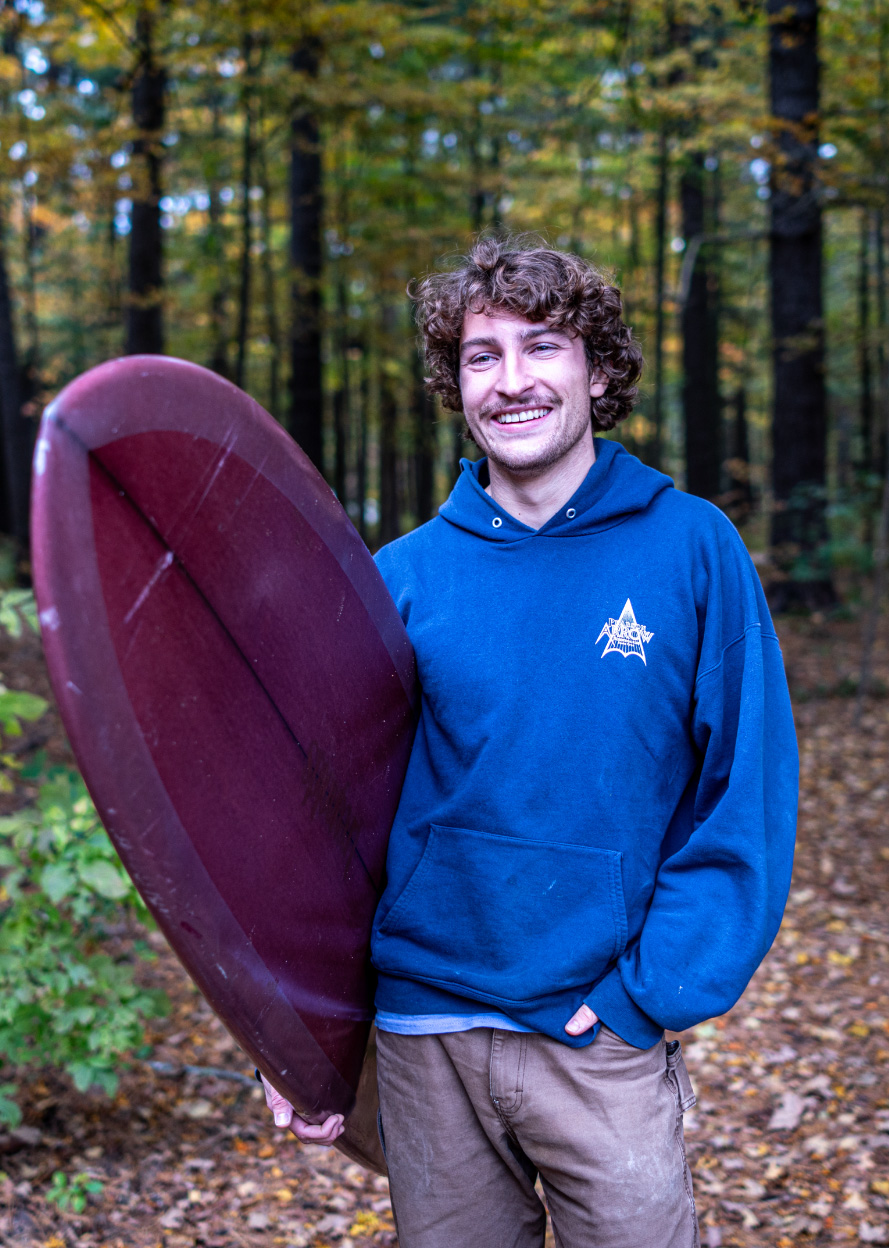
“Those people genuinely dedicated so much time to taking new people out,” said Washburn. “If I were to put myself in their shoes, that would be a lot. I really appreciated it.”
Whether it’s paddling out in a snowstorm, paddling out in a puffy, or accepting an invite to ride in the car from a surf-minded stranger you only know through a group chat, Bowdoin surfers have long had their ways of making surfing in Maine work. Some ways are crazy; other ways are just people.
I’m in Maine for a couple more days after we talk, and Hall, Washburn, and I are trying to surf. It’s October, and while there are no snowstorms in our way, the waves refuse to cooperate in a way that feels all too familiar. It’s supposed to be small and mushy all weekend, but there’s an uptick in the forecast early Monday. I hesitate to ask them to change schedules—they could very well have class that morning.
It turns out they both do, and it turns out they don’t care. They’d need to be back by ten, but they could squeeze a session in. Hall mentions her professor for that class, Chuck Dorn of the English department, surfs too. If she’s late, he’ll understand. Still, I wonder if they’ll make it.
I’m thinking again of how Menz described how people typically came into surfing here—“organic and chance ways.” That there’s a consistent group of surfers at a tiny college in the East Coast’s coldest state feels like the greatest stroke of chance of them all. But that chance has come to people who have been ready to meet it. Surfing, with its requisite attentiveness to the movements of nature, can be a way of life anywhere. But in Maine, and at Bowdoin, surfers are frozen into that practice, the joys of it hard won.
It’s harder to receive what the ocean has to offer when that ocean is forty degrees, and it’s snowing, and the only wetsuit you have is not a wetsuit at all, and you don’t have a car to drive to the beach, and you don’t see anyone in the water who looks like you.
Surfing becomes more than just an activity more quickly here than it does in other places. It’s a mark of resilience, and a connection to something deeper that can only be earned through work that is sometimes hard, sometimes spiritual, and sometimes silly. Most of the time, it’s all three.
Surf communities at Bowdoin have come and gone through the years, the scene ebbing and flowing with time. But I’m not surprised that there’s always been at least a hardy few here, working for the rewards of a life guided by the ocean.
Hall and Washburn pull up to Popham Beach, the white BOC truck’s headlights cutting through the gray morning. I wonder why I ever doubted they’d come.
Chris Ritter ’21 is a freelance writer and photographer from Lexington, Virginia, whose work has been featured by NPR, Genius, Blue Ridge Outdoors, Live For Live Music, and more.
Heather Perry is a photographer, swimmer, and travel guide based in Bath, Maine. See her work at heatherperryphoto.com.
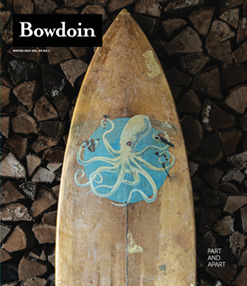
This story first appeared in the Winter 2024 issue of Bowdoin Magazine. Manage your subscription and see other stories from the magazine on the Bowdoin Magazine website.